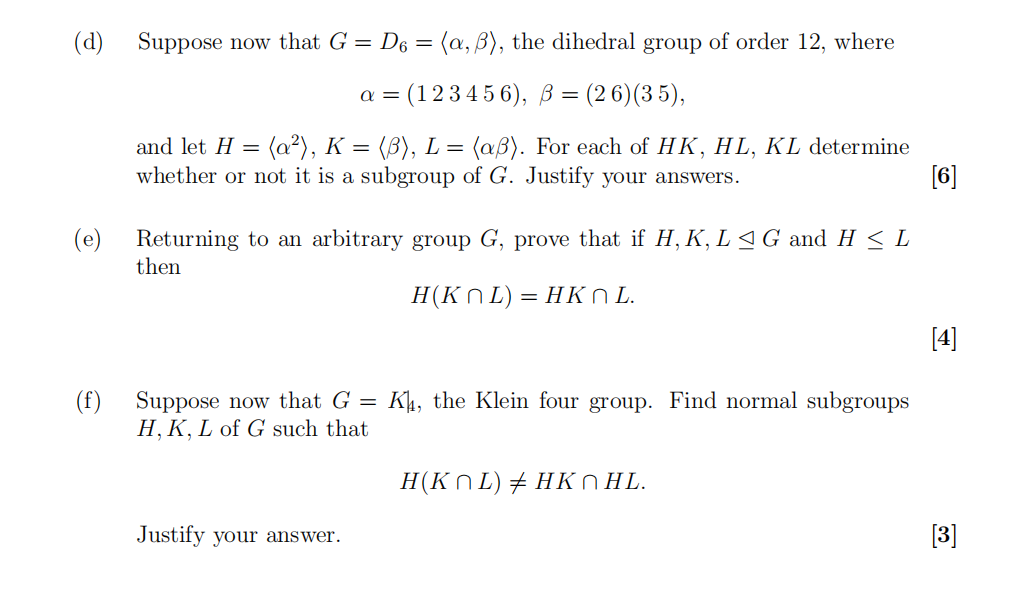MT4003 Groups
群代考 EXAM DURATION: 2 hours EXAM INSTRUCTIONS: Attempt ALL questions. The number in square brackets shows the maximum marks obtainable for that
EXAM DURATION: 2 hours
EXAM INSTRUCTIONS: Attempt ALL questions.
The number in square brackets shows the maximum marks obtainable for that question or part-question.
Your answers should contain the full working required to justify your solutions.
INSTRUCTIONS FOR ONLINE EXAMS:
Each page of your solution must have the page number, module code, and your student ID number at the top of the page. You must make sure all pages of your solutions are clearly legible.
1. 群代考
Give an example for each of the following, together with a brief explanation (1–2 sentences) of why the example is correct; you may refer to any facts from the course without proof:
(a) a non-cyclic, abelian group of order 32; [1]
(b) a non-abelian group of order 32; [1]
(c) a non-abelian group of order 36 not isomorphic to D18; [1]
(d) a group G in which the centre Z(G) is a proper subgroup, i.e.
Z(G) ≠ {e} and Z(G) ≠ G; [1]
(e) a non-trivial group in which any two elements of the same order are conjugate; [1]
(f) a non-abelian group in which there are two elements of order 3 that are not conjugate; [1]
(g) a group G such that there exists a homomorphism f : G → G which is neither a bijection nor trivial, where the trivial map is defined by f(x) = eG for all x ∈ G; [1]
(h) a simple group of order 360; [1]
(i) a non-abelian, non-simple group of order 360; [1]
(j) a group of order 8 which cannot be generated by two elements. [1]
2.
Let G be an arbitrary group, and let H, K, L be subgroups of G.
(a) Prove that the set
HK = {hk : h ∈ h, k ∈ K}
is a subgroup of G if and only if HK = KH. [4]
(b) Prove that if at least one of H or K is normal in G then HK is a subgroup of G. [1]
(c) Prove that if both H and K are normal in G then HK is also a normal subgroup of G. [2]

3. 群代考
(a) Cauchy’s Theorem states that if a prime p divides the order of a finite group G, then G has an element of order p. Explain how this result can be derived as a consequence of one of the Sylow Theorems, and state that Sylow Theorem in full. [3]
(b) List the five groups of order 12, and in each of them indicate an element of order 2 and an element of order 3. [5]
(c) (i) Explain why 〈(1 2 3 4 5)〉 is a Sylow 5-subgroup of the symmetric group S5.
(ii) Explain why every Sylow 5-subgroup of S5 is generated by a 5-cycle.
(iii) How many Sylow 5-subgroups does S5 have? Justify your answers. [3]
(d) (i) Does the 3rd Sylow Theorem uniquely determine the number of Sylow 3-subgroups of S5?
(ii) How many Sylow 3-subgroups does S5 have? Justify your answers. [3]
(e) (i) What is the order of a Sylow 2-subgroup of S5?
(ii) Find a Sylow 2-subgroup T of S5.
(iii) How many Sylow 2-subgroups does S5 have?
(iv) Find a subgroup T1 of T of order 4, and a subgroup T2 of T1 of order 2. Justify your answers. [6]

